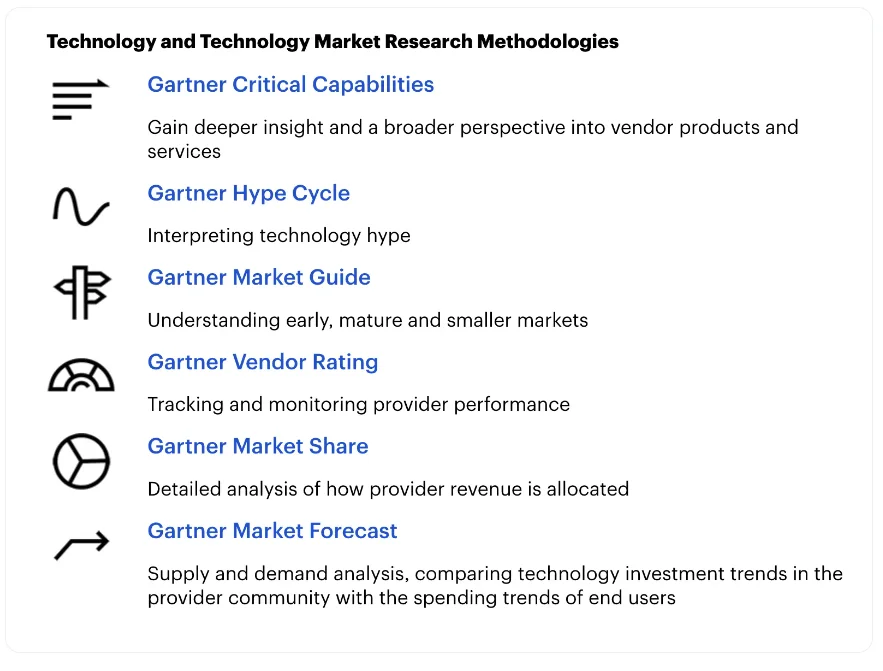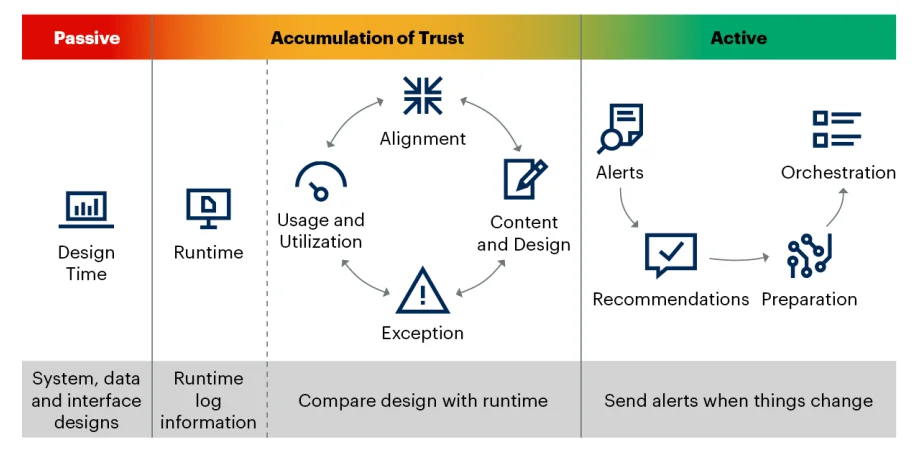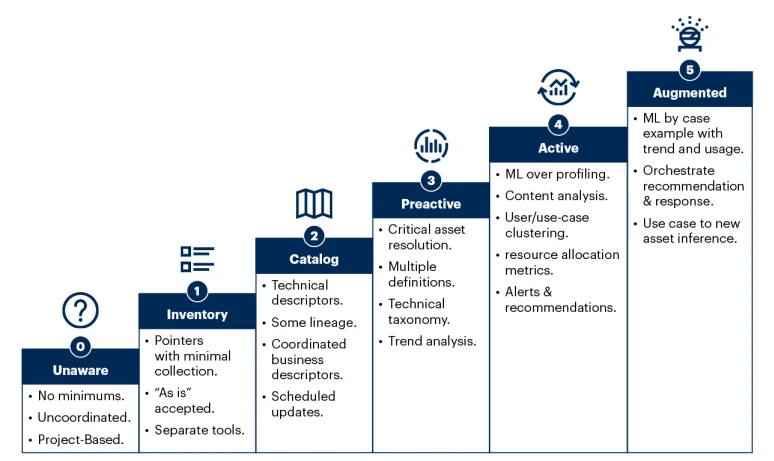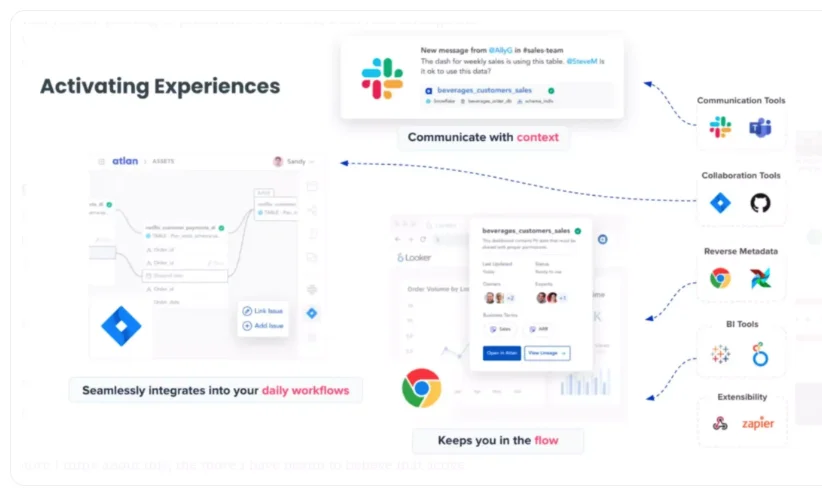Share this article
Gartner defines active metadata management as any capabilities that enable continuous access and processing of metadata to support ongoing analysis of data.
These capabilities are evolving quickly to include monitoring, evaluating, recommending design changes, and orchestrating processes in third-party data management solutions.
See How Atlan Streamlines Metadata Management – Start Tour
In this article, we’ll look at Gartner’s take on active metadata and its management. We’ll also interpret the recommendations and tooling capabilities suggested by Gartner’s market guide for active metadata management.
Gartner’s Inaugural Magic Quadrant for D&A Governance is Here #
In a post-ChatGPT world where AI is reshaping businesses, data governance has become a cornerstone of success. The inaugural report provides a detailed evaluation of top platforms and the key trends shaping data and AI governance.
Read the Magic Quadrant for D&A Governance
Table of contents #
- How does Gartner help you pick the right active metadata management tool for your enterprise?
- What is active metadata according to Gartner?
- What is active metadata management according to Gartner?
- 4 recommendations for evaluating solutions
- 8 essential tooling capabilities
- Atlan: A pioneer in the active metadata management space
- Related reads
How does Gartner help you pick the right active metadata management tool for your enterprise? #
Gartner is a $5.5 billion market research company. They have 40+ years of experience in providing research insights and guidance on technology and offering tool recommendations across industries and functions.
Gartner also enables peer connections with conferences and its peer communities to help your team use peer-driven insights for faster and better technology decisions.
Save Your Seat To See Atlan in Action - Live Demo Series
Gartner leverages its research primarily through two mediums: Research publication and tools
These include:
- Gartner Market Guide
- Gartner Magic Quadrant
- Gartner Peer Insights
- Gartner Cool Vendors
- Gartner Vendor Ratings
- Gartner Hype Cycle

Gartner market research methodologies for data governance - Source: Gartner.
What is active metadata according to Gartner? #
In August 2021, Gartner scrapped its Magic Quadrant for Metadata Management Solutions and replaced it with a Market Guide for Active Metadata.
The purpose of metadata is to help organizations understand their data assets. However, passive metadata doesn’t provide the complete picture as it doesn’t drive action and relies on human effort to curate, document, and update metadata.
On the other hand, active metadata is always-on, intelligence-driven, and action-oriented. Here’s how Gartner defines active metadata:
“Active metadata is the continuous analysis of all available users, data management, systems/infrastructure and data governance experience reports to determine the alignment and exception cases between data as designed versus actual experience.”
Gartner further elaborates on the characteristics of active metadata as metadata that:
- Is the continuous analysis of various types of metadata to determine alignment and deviations between “data as designed” and “operational experience”
- Creates a continuously evolving operational knowledge graph of which data is used, how often, by whom, for what purpose, and on which platform
- Enables automation in the data pipeline, delivers insights into characteristics of data, and optimizes user engagement
- Is a key enabler of data fabric, data mesh, microservices, data as a service (DaaS), and their continued evolution
- Supports self-service analytics and application development by automating data content, structures, availability, and discovery
Also, read → Active Metadata 101
Here’s an analogy to establish the difference between passive and active metadata clearly.
Passive metadata is a static map that shows the road networks, prominent landmarks, pitstops, etc. Meanwhile, active metadata is dynamic like your car’s GPS. It adjusts your route based on current conditions, such as real-time traffic and road closures…
In other words, active metadata monitors your data “traffic” continuously and responds to changing circumstances to guide you through the best possible route.
Also, read → 14 active metadata use cases for enterprises
What is active metadata management according to Gartner? #
According to Gartner, active metadata management operationalizes analytic outputs in the form of operational alerts and generated recommendations. It identifies the nature and extent of patterns in data operations, ultimately resulting in AI-assisted reconfiguration of data itself and operations that use that data in active metadata.

How to convert passive metadata to active metadata - Source: Gartner.
Gartner predicts that, by 2026, organizations adopting active metadata practices will increase to 30%. Active metadata practices will help them accelerate automation, insight discovery, and recommendations.
As a result, Gartner also predicts that a “stand-alone metadata management platform will be refocused from augmented data catalogs to a metadata “anywhere” orchestration platform.”
This means active metadata platforms will rise to prominence as always-on systems that create intelligence from metadata and drive action across your data estate.
Gartner also suggests that organizations adopt aggressive metadata analysis across their complete data estate. Those that do will decrease the time to delivery of new data assets to users by as much as 70%.
Gartner market guide on active metadata management: 4 recommendations for evaluating solutions #
How does this translate into tooling? According to Gartner, you should consider the following factors while looking for active metadata management solutions:
- Adopt metadata management solutions that accept parameterized instructions to alter design inputs- e.g., job flow, resource allocation - and manage precedent/dependent processing calls to third-party tools.
- Assess current data management tools and platforms by evaluating their capability to share internal metadata to support broader platform-to-platform orchestration.
- Replace tools that share their design-based metadata with those demonstrating active metadata capabilities. E.g., tools/platforms that can export their own metadata and import “foreign” metadata relative to existing metadata, processing instructions, and optimization strategies.
- Enable support for automated system changes in adjacent data management systems. Leverage tools that support metadata analytics workflow management capabilities, including collaborative design capabilities.
Gartner market guide on active metadata management: 8 essential tooling capabilities #
What do these factors look like as tool capabilities? Gartner highlights 8 core capabilities of active metadata management platforms. This isn’t an exhaustive list, but a starting point when comparing active metadata management solutions.
- ML for profiling: Leverage ML models to profile data and offer predictions on how this data can be used to get insights.
- Content analysis: Evaluate text (documents, oral communication, and graphics) to draw inferences from data and highlight how it could drive action.
- User/use-case clustering: Create clusters by grouping together similar users and use cases. These tools can also recommend similar content to help data practitioners get richer context. They can also analyze these clusters to automatically detect anomalies and outliers, thereby improving data quality and completeness.
- Resource allocation metrics: Automatically distribute resources — storage allocation, task scheduling, app scaling, etc.
- Alerts and recommendations: Generate alerts and offer recommendations by continuously monitoring metadata information.
- ML by case example with trends and usage: Analyze usage metadata to offer suggestions on better using your data assets.
- Orchestrate recommendation and response: Constantly track technical metadata (design and runtime metadata) from connected data products to send alerts and offer recommendations.
- Use case to new asset inference: Compare newly generated metadata with existing passive metadata to identify trends, analyze usage patterns, and offer suggestions.
Key takeaway #
These tools are an evolution from passive data catalogs that merely populated data asset descriptions and offered lineage mapping to provide a picture of your data estate.
Active metadata management tools are dynamic, constantly updating data assets as and when things change. They enable a bidirectional flow of metadata from the tool to all the connected data products and vice versa.

Metadata management technology maturity - Source: Gartner.
Tooling options #
Gartner’s market guide for active metadata management also identifies some vendors who provide active metadata management and data cataloging capabilities. These include:
- Atlan
- AWS Glue
- Google Cloud
- Microsoft Azure Data Catalog and its evolution Azure Purview
- Oracle Enterprise Metadata Management (OEMM)
Find the complete Gartner Active Metadata Management report here.
Gartner resources to understand the trends in active metadata management: #
- Quick answer: What is active metadata?
- Market guide for active metadata management
- Metadata management (EMM) solutions reviews and ratings 2024
- How to activate metadata to enable a composable data fabric
- Case study: An active metadata-augmented data classification system to boost analytics efficiency
- Deploying effective metadata management solutions
Atlan: A pioneer in the active metadata management space #
Atlan is the only modern data catalog that activates metadata. With Atlan, you can set up a data ecosystem that’s personalized, collaboration-first, and automated. You can also allocate compute resources dynamically, proactively alert downstream consumers of potential changes/issues, define access control policies at scale, and more.

What an active metadata management platform looks like - Image by Atlan.
Humble brag alert! Atlan has been featured in Gartner reports on active metadata management, data cataloging, DataOps, and more:
- Market Guide for Active Metadata Management
- Augmented Data Catalogs: Now an Enterprise Must-Have for Data and Analytics Leaders
- Cool Vendors in DataOps
- Tool: Vendor identification for data and analytics governance platforms
- Hype Cycle for Data Management
- Hype Cycle for Emerging Technologies
- Hype Cycle for Enterprise Information Management
In the latest Forrester Wave™ Enterprise Data Catalogs, Q3 2024 report, Atlan secured the highest score possible in 15 criteria under Current Offering and Strategy. The Forrester Wave™ report evaluated 12 data catalog solutions, including Atlan and Alation, across 24 criteria.
Atlan is also currently the sole leader of the G2 Grid® for Active Metadata Management - a category introduced as recently as June 2022. This distinction arguably credits Atlan as a pioneer in the space and as the company defining the category…
If you’re looking into active metadata management platforms, then get hands-on with Atlan and explore how it can help you with data enablement, discovery, quality, security, and more.
Gartner active metadata management: Related reads #
- Gartner Data Catalog Research Guide — How To Read Market Guide, Magic Quadrant, and Peer Reviews
- A Guide to Gartner Data Governance Research — Market Guides, Hype Cycles, and Peer Reviews
- Active Metadata: Your 101 Guide From People Pioneering the Concept & It’s Understanding
- The G2 Grid® Report for Data Governance: How Can You Use It to Choose the Right Data Governance Platform for Your Organization?
- The G2 Grid® Report for Machine Learning Data Catalog: How Can You Use It to Choose the Right Data Catalog for Your Organization?
- Data Catalog: What It Is & How It Drives Business Value
- What Is a Metadata Catalog? - Basics & Use Cases
- Modern Data Catalog: What They Are, How They’ve Changed, Where They’re Going
- Open Source Data Catalog - List of 6 Popular Tools to Consider in 2024
- 5 Main Benefits of Data Catalog & Why Do You Need It?
- Enterprise Data Catalogs: Attributes, Capabilities, Use Cases & Business Value
- The Top 11 Data Catalog Use Cases with Examples
- 15 Essential Features of Data Catalogs To Look For in 2024
- Data Catalog vs. Data Warehouse: Differences, and How They Work Together?
- Snowflake Data Catalog: Importance, Benefits, Native Capabilities & Evaluation Guide
- Data Catalog vs. Data Lineage: Differences, Use Cases, and Evolution of Available Solutions
- Data Catalogs in 2024: Features, Business Value, Use Cases
- AI Data Catalog: Exploring the Possibilities That Artificial Intelligence Brings to Your Metadata Applications & Data Interactions
- Amundsen Data Catalog: Understanding Architecture, Features, Ways to Install & More
- Machine Learning Data Catalog: Evolution, Benefits, Business Impacts and Use Cases in 2024
- 7 Data Catalog Capabilities That Can Unlock Business Value for Modern Enterprises
- Data Catalog Architecture: Insights into Key Components, Integrations, and Open Source Examples
- Data Catalog Market: Current State and Top Trends in 2024
- Build vs. Buy Data Catalog: What Should Factor Into Your Decision Making?
- How to Set Up a Data Catalog for Snowflake? (2024 Guide)
- Data Catalog Pricing: Understanding What You’re Paying For
- Data Catalog Comparison: 6 Fundamental Factors to Consider
- Alation Data Catalog: Is it Right for Your Modern Business Needs?
- Collibra Data Catalog: Is It a Viable Option for Businesses Navigating the Evolving Data Landscape?
- Informatica Data Catalog Pricing: Estimate the Total Cost of Ownership
- Informatica Data Catalog Alternatives? 6 Reasons Why Top Data Teams Prefer Atlan
- Data Catalog Implementation Plan: 10 Steps to Follow, Common Roadblocks & Solutions
- Data Catalog Demo 101: What to Expect, Questions to Ask, and More
- Data Mesh Catalog: Manage Federated Domains, Curate Data Products, and Unlock Your Data Mesh
- Best Data Catalog: How to Find a Tool That Grows With Your Business
- How to Build a Data Catalog: An 8-Step Guide to Get You Started
- The Forrester Wave™: Enterprise Data Catalogs, Q3 2024 | Available Now
- How to Pick the Best Enterprise Data Catalog? Experts Recommend These 11 Key Criteria for Your Evaluation Checklist
- Collibra Pricing: Will It Deliver a Return on Investment?
- Data Lineage Tools: Critical Features, Use Cases & Innovations
- OpenMetadata vs. DataHub: Compare Architecture, Capabilities, Integrations & More
- Automated Data Catalog: What Is It and How Does It Simplify Metadata Management, Data Lineage, Governance, and More
- Data Mesh Setup and Implementation - An Ultimate Guide
Share this article













